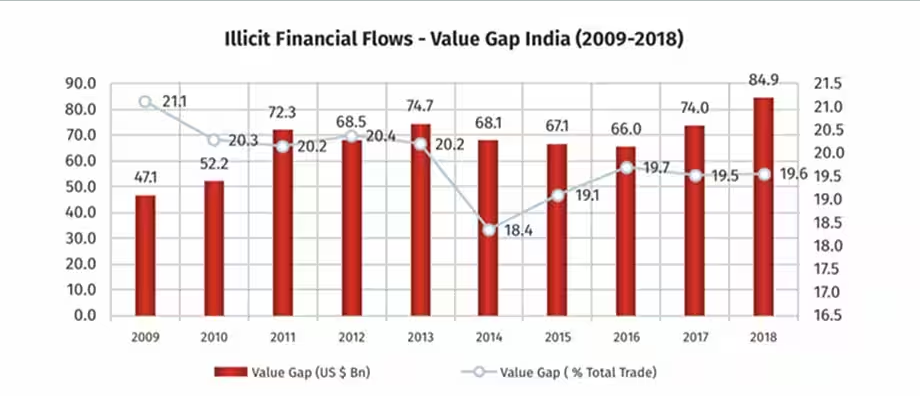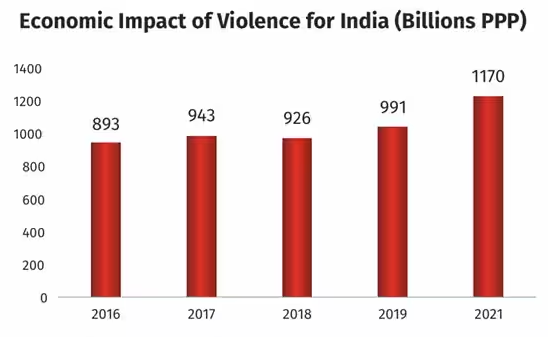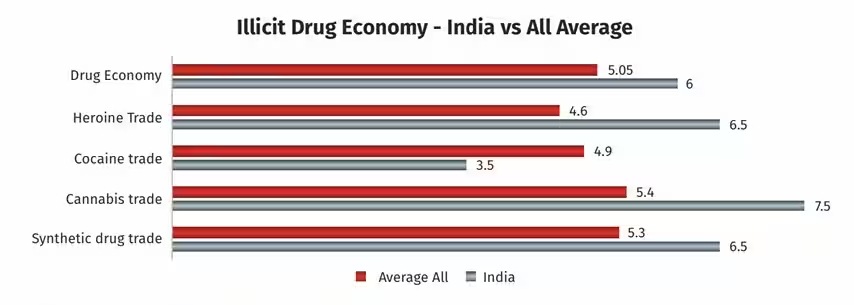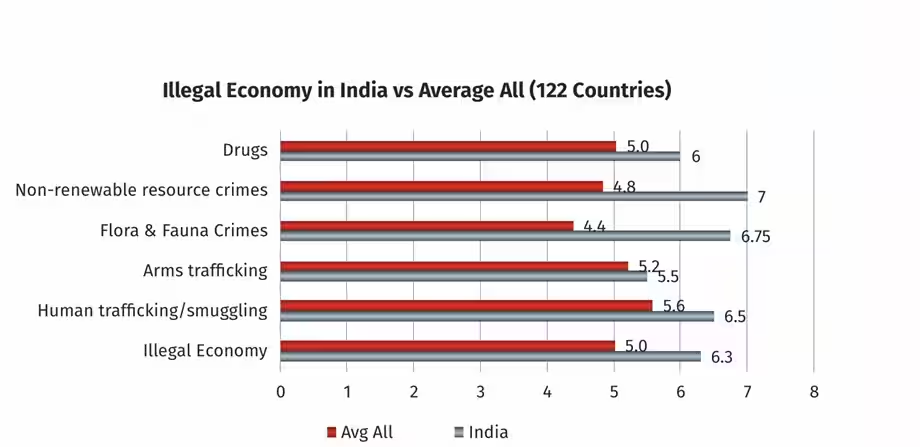Illicit Trade in India | 04 Oct 2023
For Prelims: Illicit Trade in India, FICCI CASCADE, Illicit Markets, Financial Flows, Organised Crime and Terrorism, Money Laundering, Red Sanders, GDP (Gross Domestic Product).
For Mains: Ilicit Trade in India and its implications on Indian Economy.
Why in News?
As per a report released by FICCI CASCADE titled ‘Hidden Streams: Linkages Between Illicit Markets, Financial Flows, Organised Crime and Terrorism’, the illegal economy in India has an overall score of 6.3 in India on a scale of 1-10, which is higher than the average score of 5 of other 122 countries indicating a substantial illegal Economy.
What is FICCI CASCADE?
- FICCI CASCADE (Committee Against Smuggling and Counterfeiting Activities Destroying Economy), is an initiative by the Federation of Indian Chambers of Commerce and Industry (FICCI).
- It was established on 18th January, 2011 in order to address the pressing issue of illicit trade in counterfeits, pass-offs, and smuggled goods in India and globally.
What is Illicit Trade?
- Illicit trade refers to the illegal exchange of goods, services, or commodities that circumvent established laws, regulations, or controls set by governments or international bodies.
- These activities occur outside the legal framework and often involve various forms of contraband, counterfeiting, piracy, smuggling, tax evasion, Money Laundering, and other illicit activities.
What are the Key Highlights of the Report?
- Overview of Illicit Trade in India:
- 3.5 tonnes of gold, 18 crore cigarette sticks, 140 metric tonnes of Red Sanders, and 90 tonnes of heroin were seized in the Financial Year of 2022-23.
- India has a lower score of 4.3 compared to the average score of 5.2 for 122 countries, suggesting a lesser involvement of organised crime actors but a significant influence of criminal networks.
- Illicit Financial Flows in India:
- Value Gap India (2009-2018):
- India faced an approximate total potential revenue loss of USD 13 billion due to misinvoiced imports and exports during 2009-2018.
- Uncollected value-added tax (VAT) amounted to a total of USD 3.4 billion, contributing to the revenue gap.
- India faced an approximate total potential revenue loss of USD 13 billion due to misinvoiced imports and exports during 2009-2018.
- Value Gap India (2009-2018):
- Terror and Crime in India:
- Dealing with terrorism and crime cost India approximately USD 1170 billion at Purchasing Power Parity (PPP) in 2021, accounting for about 6% of the country's GDP (Gross Domestic Product).
- PPP is a metric used by macroeconomic analysis that compares different countries' currencies through a "basket of goods" approach, allowing them to compare economic productivity and standards of living between countries.
- Dealing with terrorism and crime cost India approximately USD 1170 billion at Purchasing Power Parity (PPP) in 2021, accounting for about 6% of the country's GDP (Gross Domestic Product).
- Drug Economy in India:
- India’s location near major drug-producing regions, including the Golden Triangle (Myanmar, Laos, and Thailand) and the Golden Crescent (Afghanistan, Pakistan, and Iran) has been associated with activities that may involve the transportation and distribution of controlled substances.
- India has seen a rise in illicit drug trade, with 3,172 cases of drug seizures recorded during 2014-2022 compared to 1,257 cases during 2006-2013.
- Cannabis has a significant presence in India with a score of 7.5 compared to the benchmark average of 5.4. Synthetic drug trade and heroin trade also exceed benchmark averages with scores of 6.5.
- Organised Crime and Illegal Economy in India:
- Aggregate score of organized crime actors in India is low, at 4.3 compared to the average benchmark of 5.2 for 122 countries.
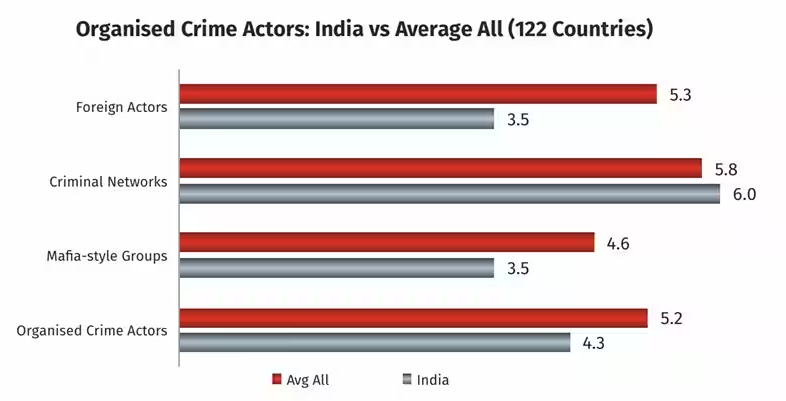
- The criminal network, however, has a significant influence in India with a score of 6, which is higher than the average score of 5.8 for 122 countries.
- The illegal economy in India has an overall score of 6.3, which is higher than the average score of 5 of 122 countries.
- This suggests that although there are fewer criminal actors, they are widespread and engage in a variety of unlawful activities, including drug and human trafficking and the illegal trade in wildlife products.
- This apparent contradiction may be attributable to the efficacy of criminal networks in India, which enables them to generate substantial illicit financial flows despite their small numbers.
- Aggregate score of organized crime actors in India is low, at 4.3 compared to the average benchmark of 5.2 for 122 countries.
What are the Government Initiatives to Tackle Illicit Trade in India?
- Terror Funding and Fake Currency (TFFC) Cell
- The Narcotic Drugs and Psychotropic Substances Act, (NDPS) 1985
- National Action Plan for Drug Demand Reduction
- National Fund for Control of Drug Abuse
- Prevention of Money-Laundering Act, 2002 (PMLA)
- PMLA (Amendment) Act, 2012
- The Smugglers and Foreign Exchange Manipulators (Forfeiture of Property) Act, 1976
- The Fugitive Economic Offenders Act, 2018
- The Black Money (Undisclosed Foreign Income and Assets) and Imposition of Tax Act, 2015
UPSC Civil Services Examination, Previous Year Questions (PYQs)
Prelims
Q. Consider the following statements:
- The United Nations Convention against Corruption (UNCAC) has a ‘Protocol against the Smuggling of Migrants by Land, Sea and Air’.
- The UNCAC is the ever-first legally binding global anti-corruption instrument.
- A highlight of the United Nations Convention against Transnational Organized Crime (UNTOC) is the inclusion of a specific chapter aimed at returning assets to their rightful owners from whom they had been taken illicitly.
- The United Nations Office on Drugs and Crime (UNODC) is mandated by its member States to assist in the implementation of both UNCAC and UNTOC.
Which of the statements given above are correct?
(a) 1 and 3 only
(b) 2, 3 and 4 only
(c) 2 and 4 only
(d) 1, 2, 3 and 4
Ans: (c)
Mains
Q. In one of the districts of a frontier state, narcotics menace has been rampant. This has resulted in money laundering, mushrooming of poppy farming, arms smuggling and near stalling of education. The system is on the verge of collapse. The situation has been further worsened by unconfirmed reports that local politicians as well assume senior police officers are providing surreptitious patronage to the drug mafia. At that point of time a woman police officer, known for her skills in handling such situations is appointed as Superintendent of Police to bring the situation to normalcy.
If you are the same police officer, identify the various dimensions of the crisis. Based on your understanding, suggest measures to deal with the crisis. (2019)

